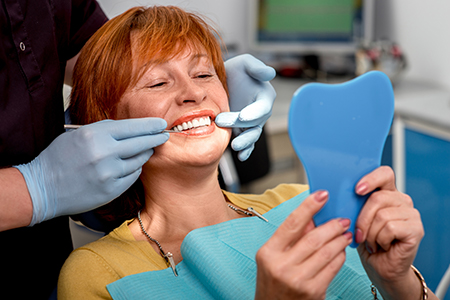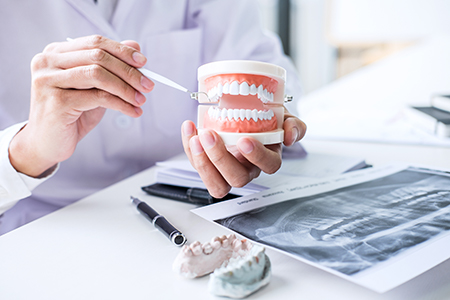Advances in dental materials and techniques have made tooth replacement more natural-looking and functional than ever. While dental implants and fixed bridgework remain excellent options for many patients, removable dentures continue to be a reliable way to restore a complete smile. Dentures can be designed to look lifelike, support facial contours, and help you eat and speak with confidence.
Our practice focuses on crafting removable restorations that balance comfort, durability, and esthetics. A well-made denture does more than replace teeth — it re-establishes the oral foundation that supports healthy speech, nutrition, and facial form. The goal is a result that feels secure and integrates smoothly with your daily life.
If you or a loved one are exploring tooth-replacement options, it helps to understand how missing teeth affect oral health and how modern dentures can address those changes. Replacing teeth sooner rather than later supports better function and long-term tissue health.
Losing one or more teeth is common and, for many people, has consequences that go beyond appearance. Missing teeth can make it harder to bite and chew a varied diet, and altered chewing patterns may lead to digestive or nutritional changes over time. Gaps in the dentition also influence the way the lips and cheeks are supported, sometimes causing the face to appear sunken or aged.
Teeth that surround an open space can drift or tilt into the gap, which disrupts bite relationships and creates areas that are harder to keep clean. Without tooth roots stimulating the underlying jawbone, bone volume gradually declines — a process often referred to as resorption. Over months and years, these changes affect how future restorations will fit and function.
Dentures — whether partial or complete — are designed not only to fill spaces but to restore daily function and facial support. Replacing missing teeth helps preserve the remaining natural dentition, maintains more normal chewing patterns, and gives patients an immediate improvement in appearance and confidence.

A denture is a removable appliance made up of artificial teeth set into a supportive base that rests on the gums. The base is shaped to follow the contours of the mouth and to distribute biting forces evenly. Modern denture teeth are available in a range of shades and shapes so the final prosthesis can be matched to a patient’s natural smile and facial anatomy.
Materials have improved substantially in recent years: denture bases are commonly crafted from durable acrylic resins or hybrid materials, while teeth may be acrylic or porcelain depending on the clinical goals. The combination of materials and careful laboratory work determines the durability, esthetics, and weight of the finished denture.
Unlike fixed restorations, removable dentures can be taken out for cleaning and for tissue care, which simplifies hygiene for many patients. In addition, removable designs allow for adjustments and relines over time to maintain comfort as the shape of the mouth changes naturally with age or after extractions.
Choosing the right denture begins with a careful clinical evaluation. We assess the health of any remaining teeth, the condition of the gums and supporting bone, bite relationships, and the patient’s goals for comfort and appearance. This comprehensive review guides whether a partial denture, a full denture, or a denture with additional retention features is the best fit.
Full dentures replace all teeth in the upper jaw, lower jaw, or both and are fabricated to restore occlusion and facial support. Partial dentures fill specific gaps while preserving and clasping to remaining natural teeth, helping to stabilize the bite and prevent unwanted tooth movement. The specific design — from the shape of the base to how the teeth are set — is tailored to meet each patient’s unique anatomy and functional needs.
Our team works with dental laboratories that specialize in prosthetics to select tooth shapes, shades, and base contours that complement each patient’s facial features. The aim is a natural result that is comfortable when speaking and chewing and that blends seamlessly with any remaining natural teeth.
Complete (full) dentures are designed for mouths where all natural teeth in an arch are missing or have been removed. The success of a full denture depends on careful attention to how the denture base fits the gums and how the teeth come together in the bite. Properly made full dentures restore function and help maintain facial profile.
A conventional full denture is fabricated once the gums and bone have healed after extractions. This approach allows for a precise fit because the tissues have settled into their post-healing shape. For many patients, a conventional denture delivers an accurate, comfortable long-term result.
Immediate Denture
An immediate denture is placed at the time teeth are removed so the patient does not have to go without teeth during healing. It provides instant esthetic and functional benefits, although follow-up adjustments and relines are commonly needed as the tissues remodel.
Overdenture
An overdenture derives extra stability from attachments that connect to remaining tooth roots or to specially placed implants. This design preserves bone and can improve retention and proprioception compared with a conventional denture.
Implant-Supported Dentures
Implant-supported dentures attach to a small number of dental implants that act as anchors in the jaw. These attachments increase retention and help prevent shifting while eating or speaking, offering a secure solution for many patients.
Partial dentures are a conservative option when several natural teeth remain. They use clasps or precision attachments to gain retention on adjacent teeth and are designed to fill one or more gaps without disturbing healthy teeth unnecessarily. Partial dentures also help keep the remaining teeth in their proper positions.
Today’s partials can be made from a variety of frameworks — from traditional cast metal to lighter, flexible resins — depending on the case requirements and patient preferences. Material choice affects strength, esthetics, and weight, and the design is always selected to optimize comfort and function.
When a partial denture is planned, it’s important to evaluate the long-term health of the abutment teeth that will support it. Proper hygiene, periodic exams, and targeted maintenance help these teeth remain strong and stable for years to come.
Our team is experienced in creating removable restorations that are engineered to suit each patient’s oral health and lifestyle. We focus on fit, balanced occlusion, and tooth arrangement so the final prosthesis complements natural facial contours and daily function.

Designing a successful denture starts with a thorough diagnostic process. This includes a review of medical and dental history, a clinical exam, and any necessary imaging to understand bone levels and tissue anatomy. Accurate records allow us to anticipate challenges and plan for a prosthesis that fits well and functions predictably.
Impressions, bite registrations, and try-in appointments are essential steps in the fabrication process. These visits let us fine-tune tooth position, vertical dimension, and esthetic choices before the final denture is processed. Attention to each step reduces the need for extensive rework after insertion.
When indicated, we coordinate implant placement or pre-prosthetic procedures to improve comfort and retention. Whether the restoration will be a conventional denture, an overdenture, or an implant-retained prosthesis, the objective is the same: a secure, comfortable appliance that supports oral health and daily living.
Many patients appreciate a collaborative approach between the clinician, the laboratory technician, and the patient. Clear communication about expectations, function, and esthetics helps ensure a denture the wearer is pleased with for years to come. Our office applies current techniques and materials to deliver consistent, predictable outcomes.

Receiving a new denture is a significant change, and a short period of adjustment is normal. Small sore spots can develop as the tissues adapt; these are generally managed through targeted adjustments. Wearing the denture as recommended and reporting areas of irritation promptly helps speed the adaptation process.
Temporary increases in saliva production and subtle changes in speech are common at first. Practicing speaking, reading aloud, and starting meals with soft, bite-sized foods can help you build confidence. Over time, most patients find they speak and eat comfortably with their prosthesis.
Daily care is straightforward but essential: rinse and brush the denture after meals, remove it at night to give tissues an opportunity to rest, and soak it in water or a recommended cleanser when it’s not being worn. Maintain regular dental visits so we can monitor tissue health, check fit, and perform relines or adjustments when natural changes occur.
Relines restore proper contact between the denture and the gums as the underlying tissues remodel, helping preserve comfort and function. Routine checkups also include oral examinations to ensure the remaining tissues and any natural teeth are healthy and to detect issues early.
At the office of Dr. Aaron Tropmann & Dr. Gary Oyster, we emphasize personalized care and careful follow-up to help patients get the most from their dentures. If you’re considering tooth replacement options or would like to learn more about denture care and maintenance, please contact us for more information.

Dentures are removable dental appliances that replace missing teeth and the surrounding gum tissue, restoring the ability to chew, speak, and support facial contours. They consist of artificial teeth set into a base that conforms to the shape of the mouth and distributes biting forces across the gums. Modern denture teeth and bases are designed for a natural appearance and can be tailored to a patient’s smile, facial proportions, and functional needs.
The base materials commonly include durable acrylic resins or hybrid polymers, while denture teeth may be acrylic or porcelain depending on desired esthetics and wear characteristics. Unlike fixed restorations, dentures can be removed for cleaning and for gentle care of the oral tissues, and they can be adjusted or relined over time to maintain comfort as the mouth changes.
There are several common denture designs to address different clinical situations. Complete dentures replace all teeth in an upper or lower arch, while partial dentures fill one or more gaps and clasp to remaining natural teeth to preserve tooth position and bite relationships. Other variations include immediate dentures placed at the time of extraction, overdentures that use retained roots or attachments for added stability, and implant-supported dentures that anchor to dental implants for enhanced retention.
Material and framework choices vary from traditional cast metal partials to lighter flexible resins or full acrylic constructions, and each option carries tradeoffs in weight, strength, and esthetics. The appropriate type is selected after a clinical evaluation that considers remaining teeth, gum and bone health, chewing function, and the patient’s goals for comfort and appearance.
Determining whether dentures are the best solution begins with a comprehensive dental evaluation that reviews your oral health, medical history, and long-term goals. The dentist will assess the condition of remaining teeth, the health and volume of supporting bone and gums, bite relationships, and any concerns about function or esthetics. In many cases dentures are appropriate when multiple teeth are missing or when a full-arch replacement is needed and other options such as fixed bridges or implants are not suitable for medical, anatomical, or personal reasons.
The decision also takes into account lifestyle and maintenance preferences, since removable prostheses require daily care and periodic adjustments. A clear discussion of expected outcomes, alternative treatments, and the steps involved in fabrication helps patients choose the option that best supports their oral health and quality of life.
Treatment begins with a diagnostic visit that includes a review of medical and dental history, a clinical exam, and any necessary imaging to evaluate bone levels and tissue anatomy. Impressions, bite registrations, and esthetic planning appointments are used to record tooth position, vertical dimension, and desired tooth shape and shade before the laboratory fabricates the prosthesis. Try-in appointments allow the clinician and patient to refine tooth arrangement and appearance so the final denture meets functional and cosmetic goals.
If extractions or implant placement are part of the plan, the team coordinates timing and follow-up care so healing and tissue remodeling are accounted for in the prosthesis design. When appropriate, immediate dentures can be provided at the time of extraction to avoid a period without teeth, while conventional dentures are fabricated after tissues have healed to achieve a precise long-term fit.
Daily denture care is essential for oral health and the longevity of the prosthesis. Rinse and brush dentures after meals to remove food particles, and use a soft denture brush or a toothbrush with nonabrasive denture cleanser to clean all surfaces while taking care not to bend or damage any clasps or attachments. Remove dentures at night to allow the gums to rest and soak them in water or a manufacturer-recommended cleanser when they are not being worn.
It is also important to maintain regular dental visits so the clinician can evaluate tissue health, check fit, and perform relines or adjustments as needed. Clean natural teeth, implant abutments, and oral tissues thoroughly to reduce the risk of decay, gum disease, and denture-related sore spots or infections.
An adjustment period is normal as the mouth adapts to a new denture, and many patients experience temporary changes such as increased saliva, mild soreness, or slight alterations in speech. Small sore spots can develop where the denture contacts soft tissue, and these are usually resolved through targeted adjustments at follow-up visits. Wearing the denture as recommended and reporting discomfort promptly helps the clinician make timely refinements to improve comfort and fit.
Speech and chewing often improve over a few weeks as muscles learn the new oral contours; practicing speaking and starting with soft, bite-sized foods can accelerate adaptation. Long-term comfort also depends on periodic maintenance, including relines to restore a close fit as the underlying tissue contours remodel with time.
Dentures change the shape of the mouth and the way the tongue and lips interact with teeth, so short-term speech differences and changes in chewing efficiency are common. Reading aloud, practicing troublesome sounds, and gradually increasing speaking tasks can help you regain clearer speech quickly. For eating, begin with soft, evenly sized pieces and avoid very sticky or hard foods until you build confidence and muscle coordination.
Using both sides of the mouth to chew and cutting foods into smaller pieces reduces stress on the prosthesis and makes chewing more effective. For patients who need additional retention during the adaptation phase, conservative use of denture adhesives or an evaluation for attachment options such as overdentures or implant supports can be discussed with the clinician.
Implant-supported dentures use dental implants as anchors to improve retention, stability, and function compared with traditional removable bases. Small numbers of implants can support an overdenture or secure a full-arch prosthesis, reducing movement during eating and speech and often enhancing chewing efficiency and patient confidence. This approach can be especially helpful for lower dentures, which may be less stable on their own due to anatomy and tongue activity.
Ideal candidates for implant-supported dentures are generally in good overall health, have adequate bone to support implants or are willing to consider bone grafting if needed, and maintain good oral hygiene. The treatment plan requires careful evaluation and coordination between the restorative dentist and the implant surgeon to select implant number, position, and prosthesis design that meet functional and esthetic goals.
Denture longevity depends on materials, wear patterns, and how well the appliance and oral tissues are maintained; many dentures provide good service for several years before significant wear or fit changes occur. Over time, denture teeth can wear down and the supporting acrylic base may lose optimal adaptation to the gums as bone and soft tissue change, so periodic relines are commonly required to restore close contact and comfort. Routine maintenance and careful daily care slow deterioration and extend the functional life of a prosthesis.
Patients should schedule regular dental examinations so the clinician can monitor fit and function and recommend relines, rebasing, or replacement when necessary. Signs that a denture may need attention include persistent looseness, new sore spots, changes in bite, or noticeable alterations in facial support and chewing ability.
Achieving a natural look and comfortable fit begins with thorough planning, accurate records, and collaboration with experienced dental laboratory technicians to select tooth shapes, shades, and base contours that complement facial features. Impressions, bite registrations, and try-in appointments allow the team to evaluate tooth position, midline, and vertical dimension so the final prosthesis integrates with a patient’s speech, smile line, and facial proportions. Attention to balanced occlusion and even force distribution reduces the risk of sore spots and improves long-term function.
During fabrication and delivery, the clinician fine-tunes fit, makes any necessary adjustments, and provides guidance for adaptation and home care. Thoughtful follow-up and timely relining help preserve comfort and esthetics as natural changes occur, and when appropriate the office can discuss additional retention options to enhance stability and confidence.

Ready to book your next appointment or have a question for our team? We're here to help.
Connecting with our team is simple! Our friendly staff is here to help with appointment scheduling, answer any questions about your treatment options, and address any concerns you may have. Whether you prefer to give us a call, send an email, or fill out our convenient online contact form, we’re ready to assist you. Take the first step toward a healthier, brighter smile – reach out to us today and experience the difference compassionate, personalized dental care can make.